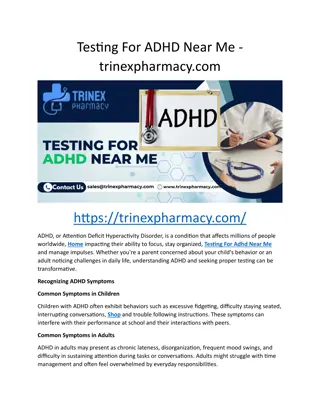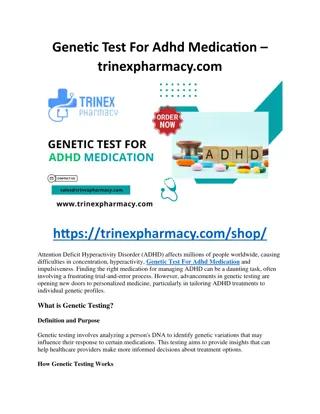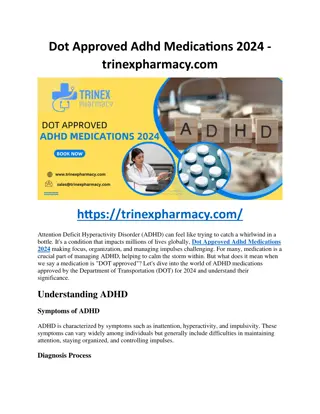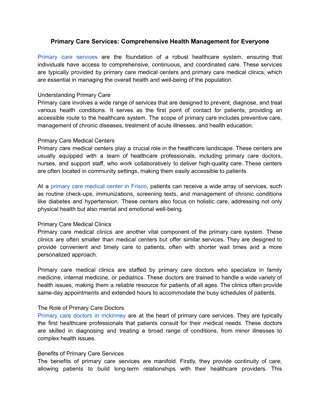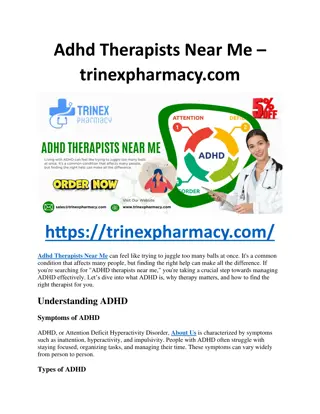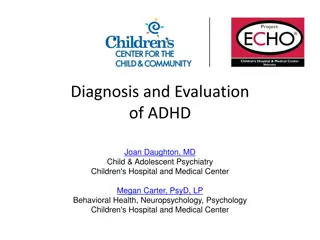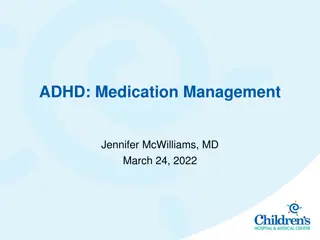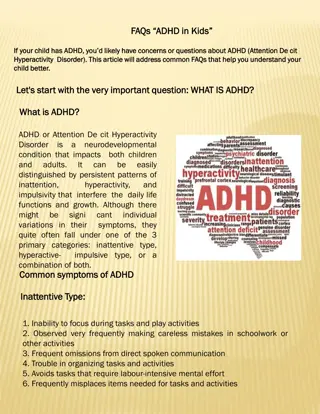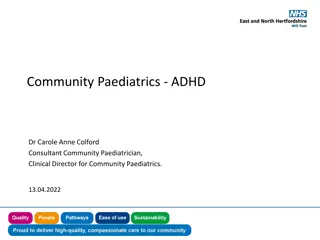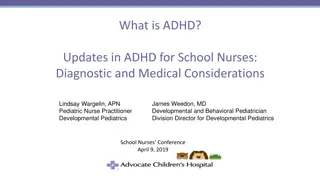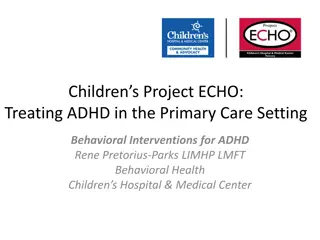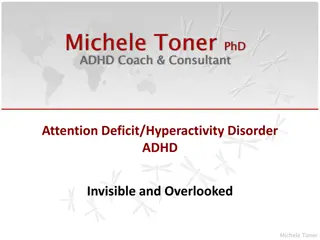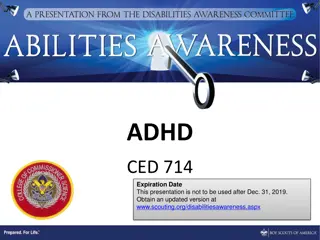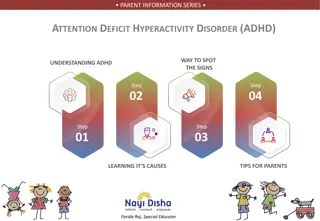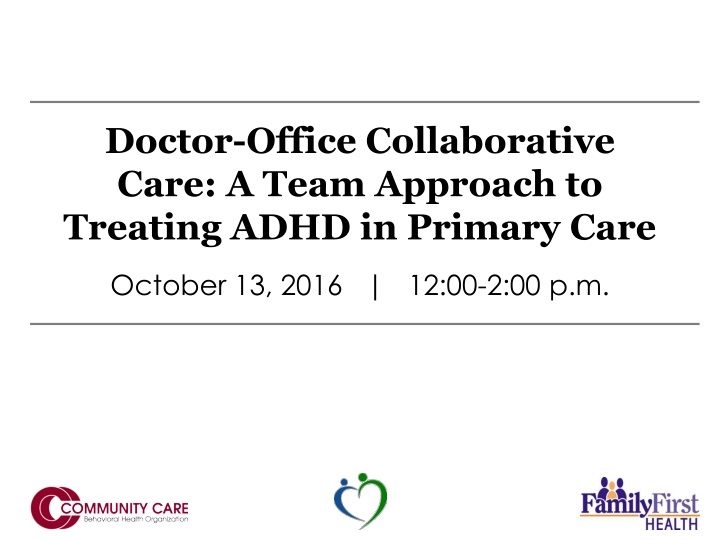
Collaborative Care Approach for Treating ADHD in Primary Care
Explore the collaborative care approach in treating ADHD in primary care settings through a team-based model, integrating physical and behavioral health services to improve patient outcomes. Learn about Community Care, a behavioral health managed care company, and their efforts to enhance coordination of healthcare services. Discover the DOCC model for integrated behavioral health treatment in primary care, focusing on psychiatric consultation and collaborative healthcare teams.
Download Presentation

Please find below an Image/Link to download the presentation.
The content on the website is provided AS IS for your information and personal use only. It may not be sold, licensed, or shared on other websites without obtaining consent from the author. If you encounter any issues during the download, it is possible that the publisher has removed the file from their server.
You are allowed to download the files provided on this website for personal or commercial use, subject to the condition that they are used lawfully. All files are the property of their respective owners.
The content on the website is provided AS IS for your information and personal use only. It may not be sold, licensed, or shared on other websites without obtaining consent from the author.
E N D
Presentation Transcript
Doctor-Office Collaborative Care: A Team Approach to Treating ADHD in Primary Care October 13, 2016 | 12:00-2:00 p.m.
Agenda Project overview Provider presentations Review Question and Answers
About Community Care Behavioral health managed care company founded in 1996; part of UPMC and headquartered in Pittsburgh Federally tax exempt nonprofit 501(c)(3) Major focus is publicly-funded behavioral health care services; currently doing business in PA and NY Licensed as a Risk-Assuming PPO in PA; NCQA- Accredited Quality Program Serving approximately 950,000 individuals receiving Medical Assistance in 39 counties through a statewide network of over 1,800 providers
HealthChoices Regions Served Erie Warren Susquehanna McKean Potter Tioga Bradford Crawford Wayne Forest Wyoming Cameron Sullivan Lackawanna Venango Elk Pike Pike Lycoming Mercer Clinton Jefferson Luzerne Clarion Columbia Montour Monroe Lawrence Clearfield Centre Union Butler Carbon Armstrong Northumberland Snyder Northampton Beaver Mifflin Schuylkill Lehigh Indiana Allegheny Juniata Blair Berks Perry Dauphin Bucks Cambria Huntingdon Lebanon Westmoreland Montgomery Washington Cumberland Lancaster Bedford Fayette Chester Somerset Franklin York Philadelphia Greene Fulton Adams Delaware Southwest Region Southeast Region North Central Region: County North Central Region: County North Central Region: County Lehigh-Capital Region Northeast Region North Central Region: County North Central Region: State Community Care Office
Health Care Coordination Efforts to improve overall wellness through integrated physical and behavioral health care Responsive to calls for coordinated care (Affordable Care Act) Enhance capacity of behavioral health providers to empower individuals to manage physical wellness Improve assessment and treatment of behavioral health disorders in primary care
DOCC Model Integrated behavioral health treatment in primary care Psychiatric consultation Collaborative health care team May result in improved behavioral health service utilization compared to non-integrated models
Pediatric FQHC LC Hint: Set a firm time frame to start and end the measurement period of the learning collaborative Six providers Six month participation and commitment Oversight and support from Community Care
What is a learning collaborative? Structured approach for change Adopt best practices in multiple settings Uses adult learning principles & techniques Time-limited learning process Shared learning & collaboration
The Breakthrough Series For articles and information about the learning collaborative model and quality improvement efforts, visit http://www.ihi.org
Why use the IHI model? Proven quality improvement record Supports skill development of clinical home staff Promotes mutual learning among participants Increases use of data to inform decisions and practice Develops infrastructure to sustain improvement Spreads new knowledge and improvement to other parts of organization
IHI Model and Structure Hint: Break the quality improvement effort into smaller cycles of measurable change
Learning Collaborative Personnel Quality Improvement Team (QIT) Upper level administrator Clinical supervisor Quality assurance Patient representative and families Consulting psychiatrist Champion
Learning Collaborative Milestones Staff Milestone 1: Lay the Foundation Date Have you reviewed and signed the learning collaborative charter? Discuss the charter and purpose of the project with key leadership Discuss the charter and purpose of the project with key providers Have you established a Quality Improvement Team (QIT) for this initiative? Executive Leadership Clinical/Quality Improvement Leadership Behavioral Health Provider Pediatrician Psychiatric Consultant Health Center patient/family member Other? Have you developed a schedule for regular meetings of the QIT? When will the QIT meet? Inform your Community Care Facilitator of meeting dates and times Have you developed a list of topics to guide PDSAs for this initiative?
Learning Collaborative Process Aims Hint: The Process Aim helps you monitor an activity important in the delivery of the new or improved practice Process Aim: Identification Screen and identify youth with ADHD Process Aim: Treatment Link youth with ADHD and families to behavioral health treatment (ex, SKIP)
Process Aim June July August Number of youth seen at the center (optional): 250 261 240 Number of completed Vanderbilts (optional): 39 25 40 Number of youth identified with ADHD: 7 10 9 Number of youth with ADHD (above) seen by the BHP: 4 5 7
Process Aim Number of Youth Identified with ADHD 12 10 Hint: Display data in tables and graphs to make change over time easier to observe 8 6 4 2 0 June July August September October November December
Learning Collaborative Outcome Aim Hint: The Outcome Aim helps you monitor the impact of the new or improved practice on individuals Outcome Aim: ADHD Improvement By December 31, 2016, 60% of youth with a Vanderbilt score indicating ADHD will show improvement
Outcome Aim Defined First Vanderbilt Second Vanderbilt Inattention (1-9) Hyperactivity (10-18) Inattention (1-9) Hyperactivity (10-18) Outcome of 1st Vanderbilt Date of 1st Vanderbilt # items scored 2 or 3 # items scored 2 or 3 Date of 2nd Vanderbilt # items scored 2 or 3 # items scored 2 or 3 ID (non-PHI)
What next? Establish a process for continuous quality improvement Use information Milestone completion, process and outcome aims Implement a quality improvement activity Seek out feedback and support QIT Monthly regional support calls Learning sessions
Quality Improvement Cycle: PDSA Act Plan Study Do
PDSA Cycle Small tests of change Hint: Make your PDSA small and focused; have a measurable objective Conduct one or more each month Measure impact of small test of change Review data Share progress with the collaborative Act on results
PDSA Worksheet PDSA Cycle June BEGIN DATE: DATE : Milestone/Fidelity: PLAN What is your objective? What question(s) do you want to answer on this PDSA cycle? What do you predict will happen? DO Did you carry out your plan? Yes No Summarize what happened.
Learning From Others Hint: Provide an opportunity for participants to share an overall experience Monthly webinar support sessions Discussion of aims, milestones, progress, challenges, successes Quarterly in person meetings and assistance Storyboard presentations
River Valley Health and Dental Center Pediatric Learning Collaborative
About RVH&DC Became an FQHC in 2012 85 employees total 10,030 total patients and 1,502 pediatric medical patients Services offered: Medical Health education Dental Urgent care Behavioral health
Pediatric Behavioral Health Flow Parent expresses concerns to provider during visit and provider or BHC gives parent the Vanderbilt to complete and instructions on follow up. Brief Intervention Type of services available to child is also discussed as well as obtaining appropriate releases to exchange information with schools/day cares. Once the child has been diagnosed with ADHD (any type) and there are little or no mood disruptions indicated, BHC schedules appointment to start SKIP. Weekly or bi-weekly appointments scheduled around school/sport/guardian schedules to meet with both patient and parent for 20-30 minutes each. Progress monitored with guardian feedback and follow up Vanderbilt screenings. SKIP
Whats next? Hiring more staff! RVH&DC providers value to accessibility of BHC Looking for 5:1 ratio First SKIP case was successful! 6 yr old male started medication and family implemented skills taught during intervention Will come in for bi-monthly medication checks
Family First Health Pediatric Integrated Care
What, Why, and How What: LC guided by Community Care; 6 mo. duration; collaboration with 5 other organizations Berks Community Health Center (FQHC Reading), JC Blair Hospital (Huntington), NEPA Community Health Care (FQHC Scranton), River Valley Health & Dental Center (FQHC Williamsport), The Wright Center Medical Residency & Primary Care Why: Gap: 6 -9% school aged children meet criteria for ADHD; most initially diagnosed & treated by PCP; greater coordination of care & improved outcomes when BH intervention is offered How: doctor office collaborative care/SKIP; evidence-based psychosocial care; 565 children, 92 PCPs, 12 practices, 8 BH clinicians Target: reduction in symptoms for children with ADHD & behavioral problems Method: Behavioral intervention for children & families, pharmacologic support as indicated
How? Tools & resources: Vanderbilt Assessment Scales Clinical assessment Treatment planning Parent management training Patient & parent psycho-educational materials Measurement-based treatment to target Referral to ancillary services
Who? Patient Care Team Primary Care Provider Patient Care Coordinator Case Manager Child & Family Patient Care Team Members Behavioral Health Consultant Additional Service Providers Teacher & School Personnel Consulting Child & Adolescent Psychiatrist
When? Timeline Pilot with limited sample of up to 20 patients in Peds Center through year end 2016 Begin training behavioral health consultants , other PCPs, PCTs in model - early 2017 Implement DOCC model at all FFH sites with behavioral health capacity by end 2017
How? Draft Workflows Chronic visit Well child check with developmental & home setting interview Parent calls with behavior concerns Provider gives parent brief overview of DOCC/SKIP model, gives Vanderbilts for parent & teacher completion; follow up visit scheduled BHC PCT calls parent before BHC visit reminds to bring completed Vanderbilts Intake/assessment with BHC parent & child; clinical interview; scoring Vanderbilt; DOCC/SKIP orientation; determine behavioral intervention alone or behavioral & pharmacological intervention Scan Vanderbilts to EHR Schedule with provider pharm consultation and schedule with BHC behavioral intervention Schedule with BHC behavioral intervention
Family First Health Commitment Six month learning collaborative participation Identification of internal team members for support project Launch seminar June 2016 training in the model Prescribed PDSAs from Community Care Monthly data workbook & case study submission Monthly 1.5 hour Learning Collaborative Call guided by Community Care et. al Prescribed QI team meetings: Community Care
Questions for the panel? Shari Hutchison Community Care Behavioral Health Barbara Vanaskie River Valley Health and Dental Center Stacey Burroughs Family First Health
The Provider Perspective The DOCC SKIP Program is designed to identify and provide evidenced-based care for children with ADHD & disruptive behaviors Could you comment on the process for responding if a patient presents with needs beyond the scope of the program, such as neurodevelopmental disorders, pediatric depression & anxiety?
The Provider Perspective What have been some of the greatest challenges that you ve encountered in piloting this model in your center?
The Provider Perspective What creative strategies have you developed to increase the return of completed parent or teacher Vanderbilt forms?
The Provider Perspective What are your plans to offer pediatric integrated care beyond the conclusion of the learning collaborative?
Thank you! Shari Hutchison hutchisons@ccbh.com Barbara Vanaskie barbv@aimhealthy.org Stacey Burroughs sburroughs@familyfirsthealth.org




